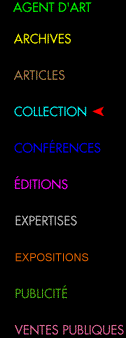
Ma collection au MAMCO
Art
& Language (Mel Ramsden)
"100% abstract"
blow up sur toile
46 x 64 cm
1968
"100 % abstract" est un tableau témoignant essentiellement de son caractère abstrait. Mel Ramsden dit à son propos qu'au lieu d'utiliser les constituants de la peinture, il préférait une description verbale des constituants de la peinture. Il produisait ainsi une abstraction d'abstraction que l'on peut comparer avec le blow up de Kosuth "Abstract" et les oeuvres de Baldwin et Atkinson de la même époque : "Painting representing nothing ..."
"These are 'virtual' paintings. They began as paintings which merely listed the chimical composition of the paint used to produce them: a kind of reflexive materialism, or a tautology of the real. They developed as elliptical forms of this : the pair of percentages 60% - 40%, for example, always add up to 100%, but they are now detached from the information on the paint can. The sense of 'abstraction' was therefore doubled in the ellipsis, as it became an ' abstraction' from - or an attenuation of - the early form which had its origin in the chemical constituents of the paint." Extrait de Art & Language in practice Vol.1 p. 145
"Comparable in approach to On Kawara's date paintings, Ramsden's paintings are similarly self-descriptive, but numbers, symbols, and punctuation marks refer to the proportions of chemicals, printed on the can, that make up the paint on the canvas instead of to the work's date of execution. His 100% Abstract paintings, in double-edged fashion, cut to the quick of ideas regarding modes of depiction based on the signifying propensity of paint. By means of fact-bearing ciphers, they suppress illusion and metaphor by representing only the physical constituents of their paint. (Anne Rorimer in "New Art in the 60s and 70s. Redefining Reality", 2001 p.102)
Art &
Language (Mel Ramsden)
"Guaranteed painting"
peinture : 25,5 x 25,5 cm
photographie : 76 x 68 cm
1967
L'oeuvre "Guaranteed painting" est composée d'une toile blanche et de l'agrandissement photographique d'un "certificat" où est inscrit : "This painting contains a square measuring 4 inches by 4 inches. It is located 3 inches from each edge"( Cette peinture contient un carré mesurant 4 inches par 4 inches. Il est situé à 3 inches de chaque bord).
L'un des premiers apports des artistes regroupés sous la dénomination de Art & Language a consisté à donner à leurs oeuvres une fonction critique par rapport à la grande abstraction américaine qui faisait autorité à la fin des années 60 mais c'est aussi avec humour que Mel Ramsden souhaite que l'on regarde cette "Garanteed painting". L'artiste dit à son sujet : "It points out the significance of the "guarantee" itself. In the mid - 60's there was an article in "Art in America" about forgery. It was called "The case of the careless collector" (Art in America, october - november, 1966). This article remarked on how artists like for example Dan Flavin and others had to issue for collectors written certificates of authenticity to accompany the sale of their work. I tried to incorporate such authenticity claims into the work itself - to see what happens when the claim contradicted what the viewer could apparently see".
Cette "Guaranteed Painting" est une oeuvre charnière entre ce qui pourrait être considéré comme l'aboutissement de la peinture (un monochrome blanc) et le début de l'art conceptuel (le blow up de la "Guarantee"). Ici le tableau blanc par sa plus petite dimension, est évidemment moins important que le concept qui va lui être substitué sous la forme de la "Guarantee". Nous pouvons voir dans cette oeuvre une façon pour Mel Ramsden de traiter de la fin de la peinture telle que l'avait espéré Malévitch avec son célèbre "Carré blanc sur fond blanc". La facture mécaniste et uniformément blanche de la peinture de Mel Ramsden constitue ce qu'aurait dû représenter le "Carré blanc sur fond blanc" : une surface monochrome toute blanche, ce qui est loin d'être son cas puisqu'il s'agit encore d'une composition très bien structurée.
L'artiste précise aussi que " The size is actually quite specific, invoking a range of non american works from Malevitch to Albers. This was not, and amphatically not, "ambitious" american post painterly painting. The work is an ironic "dedoublement" of the blank painting genre which was and is such a resource of absurd pretention".
Parce que seul le texte peut nous faire réellement prendre connaissance du contenu du tableau, ce diptyque constitue une critique de la peinture et sa prétendue existence au-delà du visible.
Si vous voulez avoir quelques explications supplémentaires sur
Art & Language
Agent d'Art, Expert-conseil
Expert honoraire près la Cour d'Appel de Paris
Membre de l'Association Internationale des Critiques d'Art
59, ave Ledru-Rollin 75012 Paris France
Tel. +33 (0)6 76 42 69 76 Email : gmolletvieville@gmail.com
